
Custom expansion joints are modeled using a combination of internal linear and lateral restraints in a node connecting pipe ends, which are removed in order to allow displacement in set directions or replaced with elastic restraints with a set flexibility. Linear restraints restrict mutual displacement of pipe cross-section along and perpendicular to the pipe axis, but do not restrict mutual rotation. Lateral restraints restrict mutual displacement of pipe cross-sections, but do not restrict mutual rotation.
If a pipe is cut at any point along the cross-section А-А (fig. 2.а) and the two-cross sections are connected with six restraints, three lateral and three linear, structural integrity is fully preserved (fig. 1).
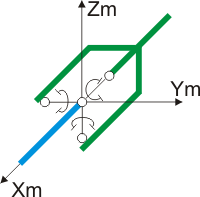
Fig. 1. Internal restraints forming a rigid connection of two pipes for a spatial system
Since it is hard to imagine the functioning of a spatial system, let's look at a flat system for clarity (fig. 2). To connect two pipe ends to the left and right of the А-А cross-section, three restraints are sufficient for a flat structure: two linear, forming an anchor along and perpendicular to the pipe axis, and one lateral, restricting mutual rotation (fig. 2.b or c). Since a rigid lateral restraint is hard to show, fig. 2.b and c replaces the lateral restraint with two parallel rigid linear restraints (horizontal and vertical).

Fig. 2. Internal restraint creating a rigid connection of two pipes for a flat system
The function of any expansion joint can be modeled by deleting one or several of internal restraints in the relevant pipe cross-section:
If one linear restraint restricting mutual cross-section displacement perpendicular to the pipe axis is deleted, a lateral expansion joint is modeled (fig. 3.а), with elements sliding perpendicular to the pipe axis.
If a lateral restraint is deleted, pipe elements can rotate relative to each other. This models an angular expansion joint (fig. 3.b).
If a linear restraint restricting displacement along the pipe axis Xm is deleted, a movable joint is created, where pipe elements can move towards and away from each other, but cannot move perpendicular to the pipe axis or rotate. This models an axial expansion joint with a large flexibility (fig. 3.c).
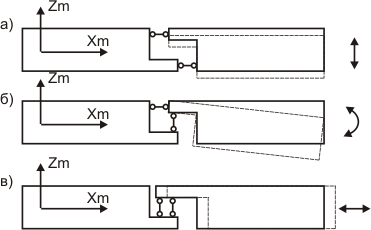
Fig. 3. Deleting one of three internal restraints models lateral (a), angular (b) and axial (c) expansion joints
In fact, restraints cannot be fully deleted and they are replaced with elastic restraints with a certain flexibility (fig. 4). Frictional forces in restraints are usually negligible.

Fig. 4. Longitudinal, transverse and rotational elastic restraints in an expansion joint
The described structures are idealized versions which do not fully match real structures, especially for axial and lateral expansion joints. The properties of a real expansion joint (or to be more exact, an expansion mechanism) are reduced to one point – a node connecting two rods, which is not realistic. For example, fig. 4 shows a model of a lateral expansion joint with an intermediate pipe.
The construction length L of such expansion joints is long. But in a model, relative displacement of connected pipe ends occurs in one point placed at the center of the expansion joint. In this way, the real structure is changed to a model (fig. 5.a.c), where cross-sections are displacement relative to each other in one point, while to the left and right of this point are pipe elements with a length of L/2 (fig. 5.b.d).
A lateral expansion joint odel restricts rotation and longitudinal displacement of pipe ends. However, a real structure does not always have these properties. For example, without certain supporting restraints of adjoining pipe elements (fig. 6) or special structures, e.g. tie (fig. 7), a lateral expansion joint diagram (fig. 5, а.c) will not match the model shown on fig. b and d, since adjoining pipe elements can freely rotation relative to each and move along the pipe axis.
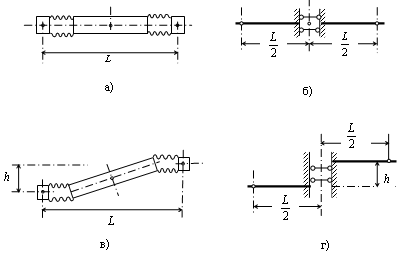
Fig. 5. Lateral expansion joint with an intermediate pipe
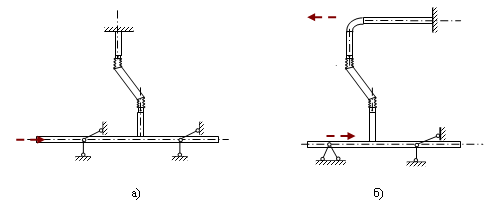
Fig. 6. Diagrams of lateral expansion joint placement on bends, ensuring their proper functioning (restricting longitudinal displacement and rotation of adjoining pipe ends)
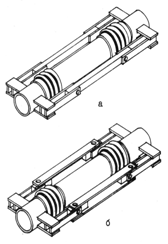
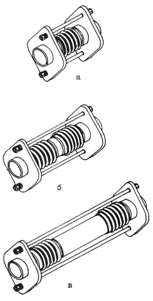
Fig. 7. Lateral expansion joints of heavy (left) and light (right) structures, restricting longitudinal displacement and rotation of adjoining pipe ends
It must be noted that the above applies not only to lateral, but also to axial expansion joints. For an axial bellows to restrict all displacement and rotation except axial displacement, adjoining pipe ends must be appropriately restrained (fig. 8). If these restraints are expansion, the bellows will function not as an axial, but as a Universal Expansion Joint.
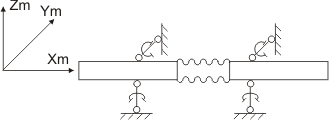
Fig. 8. Diagram of an axial bellows, ensuring its proper functioning
To simplify the placement of custom expansion joints, START-PROF contains a set of standard expansion joints. First, these expansion joints already contain the required combination of restraints; second, they automatically position the restraint directions based on the direction of local element axes. Restraints in standard START-PROF expansion joints are described below.
For full information on restraints and their directions see the "custom restraints" section
The following symbols are used to represent restraint types and properties:
 - rigid linear
double-acting restraint
- rigid linear
double-acting restraint
 - rigid lateral
double-acting restraint
- rigid lateral
double-acting restraint
 - elastic lateral restraint
- elastic lateral restraint
 - elastic linear restraint
- elastic linear restraint
thrust force is indicated with arrows
The following abbreviations are used to represent restraint types and properties:
R - rigid double-acting
E - elastic


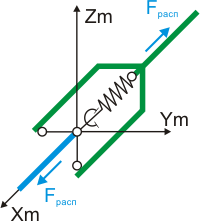
An axial expansion joint allows linear displacement along the connected pipe axis and restricts rotation of adjoining elements relative to each other, as well as linear mutual displacement perpendicular to the pipe axis. This function is ensured by the special expansion joint structure or appropriate placement of supports to the left and right of the expansion joint. Thrust force due to internal pressure must be taken into account for bellows.
A standard axial expansion joint in START-PROF removes a linear restraint along the pipe axis and replaces it with an elastic restraint, removes two lateral bending restraints (for assessing possible expansion joint skew), and takes into account thrust force Fthrust from internal pressure.
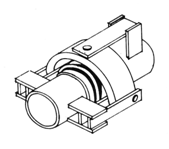
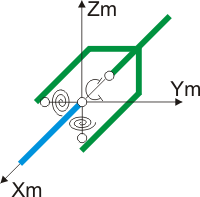
Allows mutual elastic rotation of adjoining pipe ends around vertical and horizontal axes. Restricts mutual pipe rotation, as well as linear displacement.
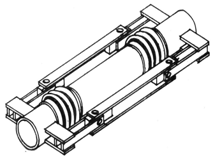
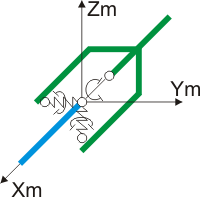
Allows linear displacement along vertical and horizontal axes of connected pipes (shift-decentering of axes). Restricts mutual displacement along the pipe axis and all rotation.
Unfortunately, it is impossible to model all real structures as a set of START-PROF expansion joints. So it is often necessary to create a custom custom expansion joint. Examples of custom expansion joints are given below:
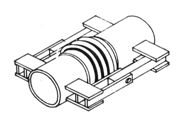
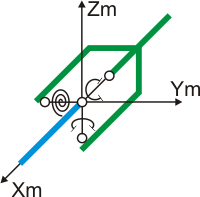
In contrast to the spatial angular expansion joint, this structure allows elastic rotation of connected pipe ends only around the horizontal axis. It restricts rotation around the vertical axis, as well as mutual pipe rotation and all linear displacement.
Manufacturers recommend not using flat expansion joints, since it is difficult to select the correct direction of tie axes. If the direction is chosen incorrectly, a large bending moment may act on the expansion joint, which will be taken on by ties. This can disable or wedge the ties. The main problem is that the necessary tie direction can significantly change depending on the state.
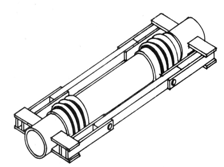
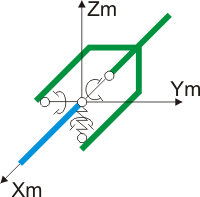
In contrast to the spatial lateral expansion joint, it allows linear displacement only along the vertical axis of connected pipes (shift-decentering of pipes). It restricts horizontal displacement, as well as mutual displacement along the pipe axis and all rotation.
See comments for flat angular expansion joints.

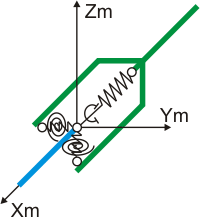
A Universal Expansion Joint is a bellows with connections or flanges on ends for connecting to adjoining pipes. It does not have a structure that allows rotation in a set direction or shift. If placed correctly, it can function as an axial expansion joint, but with a slight skew.
A Universal Expansion Joint removes three restraints in a pipe cross-section (along and perpendicular to the pipe axis) and two lateral restraints. It leaves only one of six internal restraints - lateral around the pipe axis, restricting rotation.